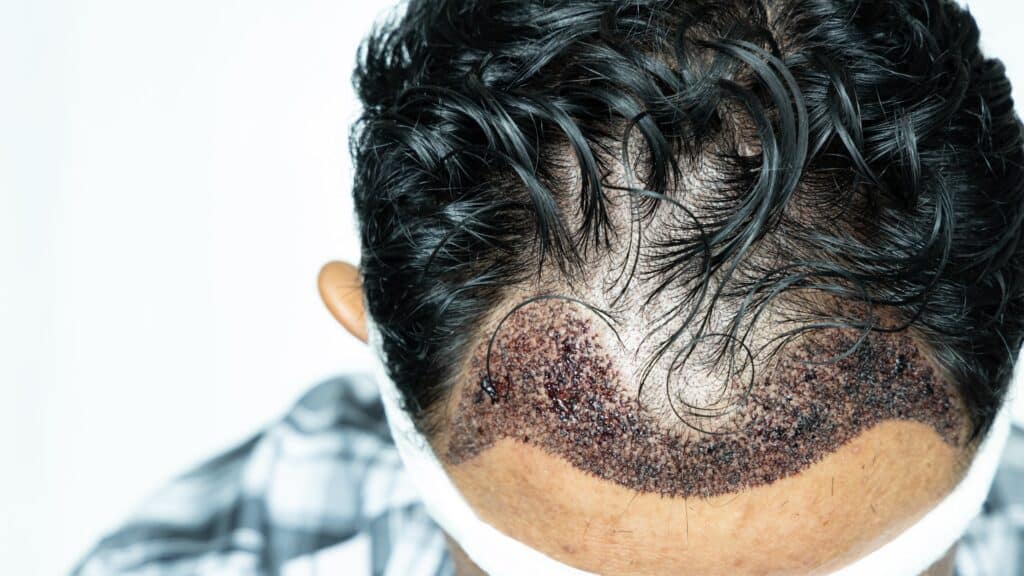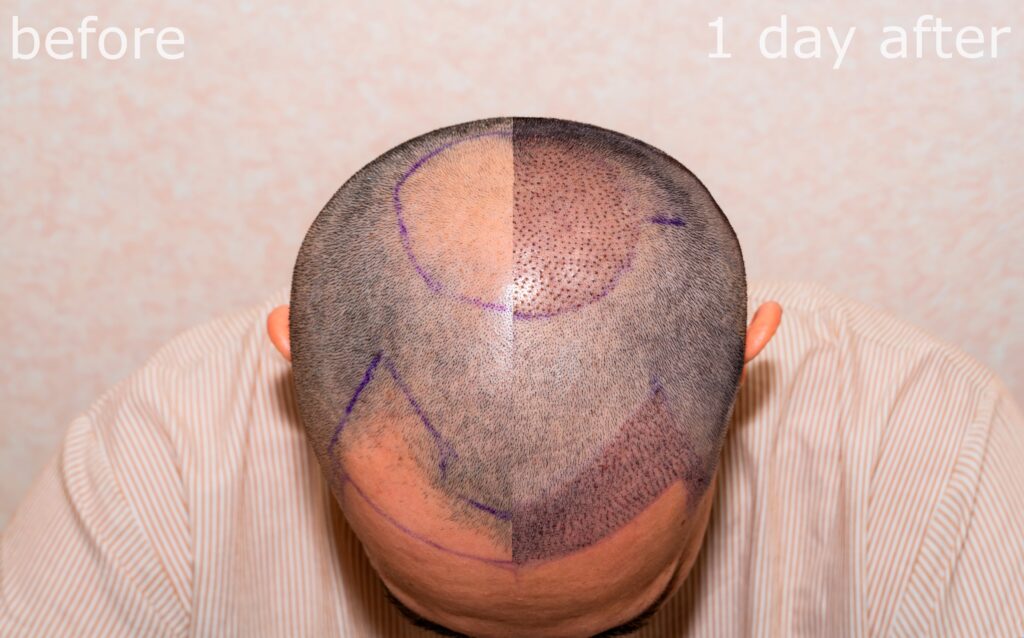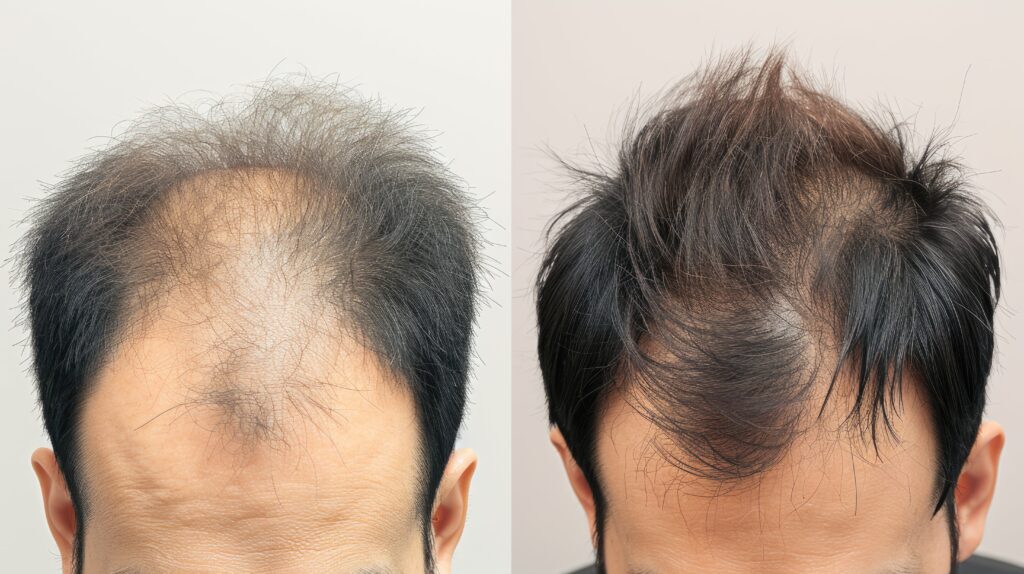Hair transplants are a popular and effective solution for hair loss. Hair transplant aftercare is important for healing and recuperation, which can have a huge impact on the final result of your hair transplant procedure. With good aftercare, your hair transplant result can last you a lifetime. Learn what to expect during a hair transplant right after and how to make sure your aftercare is as effective as possible.
How Long Does Hair Transplant Recovery Take?
A complete hair transplant recovery process takes several months. However, most of the noticeable healing occurs within the first few weeks. Within the immediate few days after your hair transplant procedure, you may experience mild symptoms such as swelling, discomfort, and scabbing, but these symptoms should all subside within a week.
Hair Transplant Recovery Stages

While many patients want to see the results of their hair transplant procedure right after it, patience is always key. A complete hair transplant recovery takes several months. The hair growth cycle works in stages. Here’s a general timeline:
2 weeks: Two weeks after your hair transplant surgery, the healing process will be well underway. While swelling should have subsided, you may still experience some redness as hair transplant scabs fall off naturally. Additionally, the newly transplanted hair grafts remain dormant during this time.
1-4 months: Transplanted hair may shed after afew weeks. These shed hairs are simply making way for new, healthier ones to emerge from the transplanted follicles. By month four, you might see some fine, delicate new hair growth. Be patient – it takes time for these new hairs to mature and reach their full thickness and texture.
4-8 months: By month four to month eight, you’ll likely start to see more noticeable progress. The newly grown hair will begin to thicken and also become increasingly visible, giving you a better idea of how your final results will look. It’s important to continue following your post hair transplant care instructions during this time, as proper care can significantly help the hair restoration process.
8-12 months: Between months eight and twelve, many patients experience significant improvements in their hair’s appearance. The transplanted hair continues to grow, and its texture becomes more defined. These positive changes contribute to a fuller, more natural-looking head of hair. By the end of the first year, you’ll have the opportunity to appreciate the full scope of your hair restoration journey. Your hair will have regained its natural thickness and appearance.
The Seven Days After the Hair Transplant

The first days after the procedure are crucial for setting the stage for a successful recovery. Understanding the different stages of hair transplant recovery in the days after surgery can help you manage expectations and ensure a smooth healing process. To help you through this first bit, here’s a day-by-day guide to hair transplant right after:
Days 1 & 2: The initial recovery
You may experience mild swelling, redness, and discomfort around the recipient area during the first two days. This is normal and should go down in a few days. It’s recommended that you give your scalp time to recover by taking up to 1 to 2 weeks off work. Prioritize getting plenty of rest to promote healing.
Days 3 & 4: Managing Pain & Discomfort
As you progress into the third and fourth days right after your hair transplant, any initial feelings of discomfort you had may start to feel more intense than before. Your surgeon might prescribe over-the-counter pain medication to help manage any lingering or increased discomfort.
On day four after your procedure, you may also be advised to wash your hair for the first time. To ensure a successful wash, pay close attention to your surgeon’s specific product recommendations and detailed instructions about washing your hair. These will help you clean your scalp gently without disturbing the grafts.
Days 5 & 6: Scabbing & Crusting
Around days 5 and 6 after your hair transplant, you’ll likely notice scabs and crusts forming around the transplanted hair follicles. This might seem alarming, but it’s actually a completely normal part of the healing process.
It’s important to wash thoroughly during these days to prevent scabbing and ensure these scabs start to loosen and wash away. Although the scabs might be itchy, try not to scratch your scalp and avoid picking or interfering with the scabs in any way. This could damage the hair grafts. Your doctor can recommend specific shampoos to help reduce the itchiness in your scalp.
Day 7: Less Scabbing, Mild Redness and the Start of Shedding
By day 7, most of the scabs should be gone, leaving your scalp slightly pink. You might also notice some hair shedding from the transplanted area.
This shedding is part of your hair’s natural growth cycle. As the transplanted follicles adjust to their new environment, they may shed the existing hair before starting to grow new, permanent hair.
Shedding can occur not only in the transplanted area but also in surrounding non-transplanted hair and even the donor site. This is temporary and shouldn’t cause concern.
Hair Transplant Post-Operative Care

Following your doctor’s post-operative instructions right after your hair transplant is vital for a successful recovery. Here are some key tips.
- Gentle washing: Continue washing your hair gently to keep your scalp clean and healthy. Avoid using harsh chemicals shampoos or rubbing your scalp.
- Avoid strenuous activity: For at least a month after surgery, avoid strenuous physical activities or anything that could harm the transplanted grafts.
- Sun Protection: Protect the transplanted area from direct sunlight for at least three months after a hair transplant surgery. Wear a hat when outdoors.
- Maintain a Healthy Lifestyle: Eating a balanced diet and getting enough sleep can promote healing and hair growth.
- Follow-up appointments: Attend all scheduled follow-up appointments. These appointments allow your surgeon to monitor your progress and address any concerns you might have.
Get Expert Aftercare Advice at Cosmedica Clinic
Hair transplant recovery is a process, but with proper care and guidance, you can expect a successful outcome. Cosmedica Clinic specialises in cutting-edge hair transplant treatments such as the FUE hair transplant and DHI Sapphire method. Dr. Levent Acar and his team are dedicated to providing exceptional care throughout your hair transplant journey, from the initial consultation to hair transplant right after and post-operative care.
If you’re looking for an affordable hair transplant clinic in Istanbul, Turkey, that prioritizes exceptional care and achieves amazing results, look no further than Cosmedica Clinic. Schedule a free consultation to discuss your hair loss concerns and explore if a hair transplant is the right solution for you.
